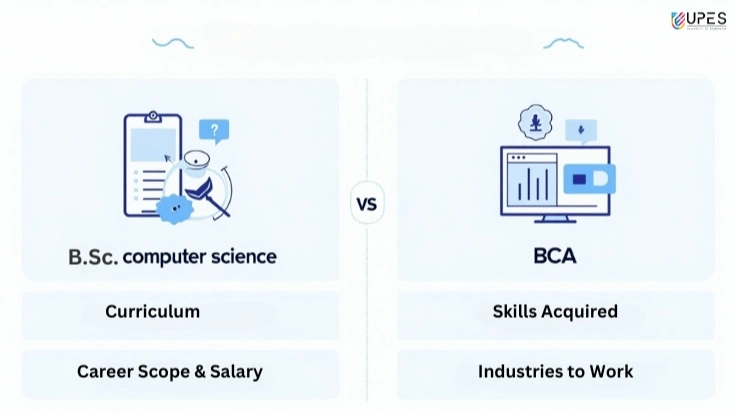How to Create a Web Developer Portfolio & Why is it important (Examples, Templates, Ideas, Content & Website)
- UPES Editorial Team
- Published 11/02/2025

Table of Contents:
With a rise in e-commerce, technological advancements, and digital transformation, every company and institution now have an online presence in the form of websites. But who makes these websites and ensures they are functioning well? It’s the blood and toil of a web developer. In simple terms, a web developer develops a website. But how do they do it? Coding and programming are two weapons they rely on to develop and maintain websites. Is their work creative? Hell, yeah! Is it easy? No! One needs to harness the right skill sets for creating interactive, interesting, and consumer-friendly websites.
Is the demand for web developers going to increase? Yes, especially with an increase in e-commerce and digitalisation. Is the competition to get a job increase too? Yes, it will, and it already has. In such a scenario how can budding web developers have an edge? The answer lies in creating a diverse, fascinating, and impressive web developer portfolio. Having a sample of your works, websites you have developed, accumulated in one place is extremely helpful when applying for a job. Always remember, a diverse, fascinating, and impressive web developer portfolio is worth a thousand words!
In this blog, having established the necessity to have a well-rounded web portfolio, we will help you in learning how to build the perfect web developer portfolio. The next time employers contact you, be ready to mesmerise them with your works.
How to Create a Web Developer Portfolio?
A web developer portfolio is a website that developers make for themselves to gather examples of the websites or projects they have developed and present them in their own unique way. Instead of showcasing your talent with words and resumes, web developers have a better chance at success if they forward their web developer portfolio website to potential employers.
Listed below is some wisdom on how to create the right web developer portfolio website to showcase your talent and improve your chances of getting hired. Remember, you've to have a degree in computer science or a similar domain to be eligible for web developer jobs. Have a look:
1. Choose the Right Platform
Selecting the right platform is crucial for your portfolio website for web developer. Popular options include:
- GitHub Pages – Best for hosting static websites.
- WordPress – Ideal for customizable portfolio websites for developers.
- React & Next.js – For dynamic and modern web apps.
- Wix & Squarespace – No-code solutions for building professional developer portfolio websites.
2. Craft an Engaging Homepage
Your homepage should have:
- A clean and responsive design.
- A brief introduction highlighting your skills and experience.
- A clear call-to-action (CTA) linking to your contact information or resume.
3. Add Real Projects & Code Samples
A web developer portfolio website must include:
- Live project links and GitHub repositories.
- Screenshots and case studies explaining project features.
- Technologies used/worke on such as HTML, CSS, JavaScript, React, or Node.js.
4. Showcase Specializations
- If you specialize in front-end development, highlight your front-end developer portfolio with animations, UI/UX designs, and responsive layouts.
- If you are a full-stack developer, ensure your full-stack developer portfolio includes backend APIs, database integration, and security implementations.
- If you're a fresher, create a fresher portfolio website by showcasing personal or academic projects.
5. Include an 'About Me' Section
A strong portfolio of web developer should introduce you with:
- A professional summary about your experience.
- Your tech stack, such as Python, React, Angular, or Node.js.
- Your career goals and interests.
6. Optimize Your Portfolio Website for Developers
Ensure your web development portfolio follows SEO best practices:
- Use meta tags and optimize for relevant keywords like "web developer portfolio examples".
- Ensure fast load times by optimizing images and using efficient code.
- Implement mobile responsiveness to cater to all devices.
7. Add Contact Information & Social Links
Your developer portfolio should have a contact section with:
- Email & LinkedIn profile
- GitHub, CodePen, or Behance links
- Resume download option
If you find yourself struggling, you can always look for inspiration from the portfolios of famous and successful web developers in the market. However, make sure to have a unique and strong voice of your own in your work.
Building a Coding Portfolio – What Content to Include?
A portfolio website design for web developer should feature:
- Landing Page Design– A well-structured homepage that represents your work.
- Portfolio Section– Display various projects with detailed descriptions.
- Blog Section (optional)– Write about coding trends, tutorials, or case studies.
- Testimonials– If you’ve worked with clients, add their feedback.
Having sections in your portfolio websites helps in maintaining clear segregation of information, avoiding information overload, and easier for content grasp. Keeping these small things in mind can go a long way in making the right impact.
Also Read: Final Year Projects for Computer Science Engineering Students
Best Web Developer Portfolio Examples
Here are some portfolio website examples for web-developer to inspire you:
1. Frontend Developer Portfolio Example
- Features: Clean UI, animations, and interactive elements.
- Best for: Showcasing JavaScript frameworks like React, Vue, or Angular.
2. Full Stack Web Developer Portfolio Example
- Features: Backend integrations, API usage, and security measures.
- Best for: Displaying end-to-end web applications.
3. Software Developer Portfolio Website Example
- Features: Python, Java, or C++ projects with a focus on algorithms and data structures.
- Best for: Software engineers and backend developers.
4. Portfolio Website for Freshers
- Features: Simple, yet professional layout with personal and academic projects.
- Best for: Entry-level developers looking for their first job.
Knowledge of what works best can be very helpful in creating the final product. Make sure you take the best and create a unique portfolio for yourself. After all, a good web developer also has a keen eyesight.
Why is a Web Developer Portfolio Important?
While we have already discussed the importance, we cannot emphasize it enough. Have a look once again to remember how much importance a portfolio holds for a web developer:
- Showcases Your Skills – A developer portfolio website allows you to exhibit your coding skills, UI/UX knowledge, and technical abilities.
- Attracts Potential Employers & Clients – Recruiters prefer candidates who have a portfolio website for developers to demonstrate real-world projects.
- Improves Credibility – A portfolio for web developer acts as proof of your expertise, making it easier to land a job or freelance opportunities.
- Enhances Personal Branding – A unique developer portfolio design sets you apart from other candidates.
We hope by the time you read these advantages, you are already getting off your couch and beginning the creation of a masterpiece of a portfolio.
Conclusion
Creating a portfolio website for software developer is a must for anyone aiming to thrive in web development. Whether you are looking for a job or freelance projects, a developer portfolio helps you demonstrate your expertise and gain credibility. By following the steps above, you can build a strong web developers portfolio that attracts recruiters and clients alike.
If you're passionate about web development and want to enhance your skills, check out the B.Tech CSE programs and BCA programs at UPES School of Computer Science.
UPES Editorial Team
Written by the UPES Editorial Team
UPES Admission Enquiry
Subscribe to UPES Blogs
Join our community for exclusive stories, insights, and updates
By clicking the "Subscribe" button, I agree and accept the privacy policy of UPES.










































